Laid down 12 February 1998 Commissioned 12 July 2003 Weight 103,000 tons Launched 4 March 2001 | Ordered 8 December 1994 Length 333 m Construction started 12 February 1998 | |
 | ||
Namesake President Ronald Reagan | ||
USS Ronald Reagan (CVN-76) is a Nimitz-class, nuclear-powered supercarrier in the service of the United States Navy. The ninth ship of her class, she is named in honor of Ronald W. Reagan, president of the United States from 1981 to 1989. Upon her christening in 2001, she was the first ship to be named for a then-still living former president.
Contents
- Women of uss ronald reagan cvn 76
- Design and construction
- Naming
- Ships seal
- Service history
- 2006 maiden deployment
- 2007 surge deployment
- 2008 deployment
- 2009 deployment
- 2010
- 2011
- 2012 and 2013
- 2014
- 2015
- 2016
- 2017
- Commanding officers
- Gallery
- References
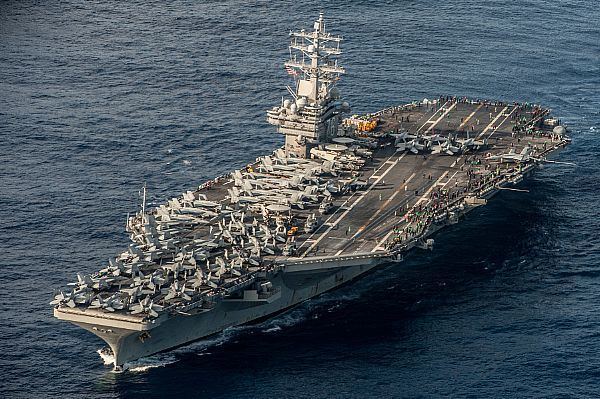
As of May 2012, the ship was operationally part of Carrier Strike Group Nine and administratively under the command of Commander, Naval Air Forces Pacific/Commander, Naval Air Forces. The two administrative titles actually refer to one command carrying out two functions. In October 2015, Ronald Reagan replaced the USS George Washington as the flagship of Carrier Strike Group Five, the only forward-based carrier strike group home-ported at Yokosuka, Japan, as part of the United States Seventh Fleet.

Women of uss ronald reagan cvn 76
Design and construction
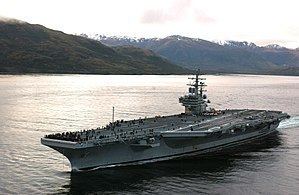
The contract to build Reagan was awarded to Northrop Grumman Newport News and Dry Dock Company in Newport News, Virginia on 8 December 1994, and her keel was laid down on 12 February 1998. The budget for the ship had to be increased several times and ultimately $4.5 billion was spent on her construction. This included a redesigned ship island. Reagan was christened by Reagan's wife Nancy on 4 March 2001 at Newport News Shipbuilding, the crew moved aboard on 30 October 2002, and the ship was commissioned on 12 July 2003 at Naval Station Norfolk, with Captain J. W. Goodwin in command. Vice President Dick Cheney and Lynne Cheney were both present at the ceremony, as well as Nancy Reagan, who gave the ship's crew the traditional first order as an active unit of the Navy: "Man the ship and bring her to life." Ronald Reagan made her maiden voyage on 21 July 2003. President Reagan, who did not attend either the launch or the commissioning due to Alzheimer's disease, died eleven months later. At the end of the graveside services, the ship's commanding officer at that time, Captain James Symonds, presented the flag that draped the former president's casket to Mrs. Reagan at her request. This was also the flag that had flown over Capitol Hill on 20 January 1981, when the president was inaugurated. At a later date, Captain Symonds also presented Mrs. Reagan the flag that had been flying over Ronald Reagan when the former president died.
Naming
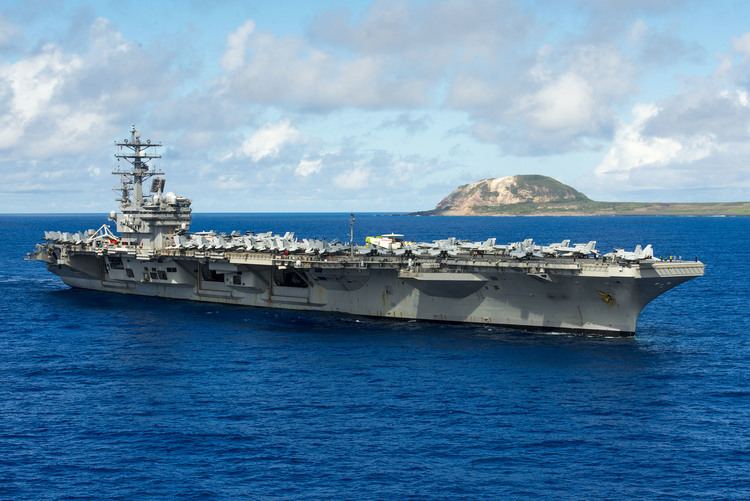
Ronald Reagan was the first nuclear-powered warship of any kind to be named in honor of a living former president. Unlike most of the other men honored by inclusion in this group, Reagan was not associated with the United States Navy, apart from his term as Commander-in-Chief, though one of his key initiatives in office was the 600-ship Navy program.
Ship's seal
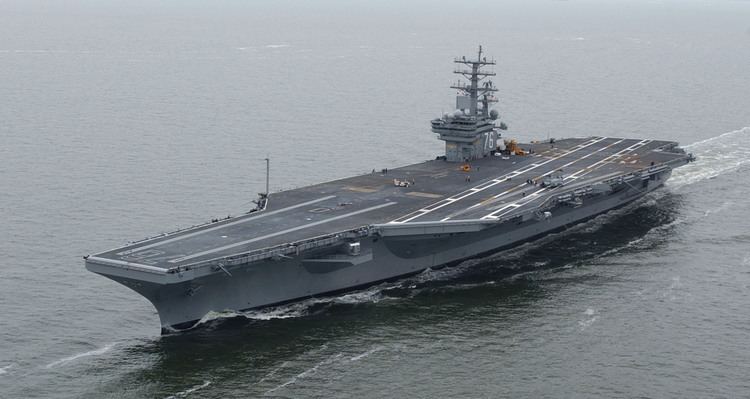
The design of Ronald Reagan's seal was created entirely by her plankowner crew with historical assistance provided by staff members at the Ronald Reagan Presidential Library foundation. The red border that rings the ship's seal is similar to the distinctive red rim that defines the White House china designed for the Reagans during their White House years. Four gold stars represent President Reagan's 40th presidency and his four pillars of freedom: individual liberty; economic opportunity; global democracy; and national pride. "Peace through Strength" was a recurring theme of the President's life in public service. The aircraft carrier is positioned by the West Coast, representing President Reagan's two terms as Governor of California and the ship's homeport in the Pacific Fleet. The three aircraft with their patriotic contrails symbolize the three major military operations the President directed during his tenure: Operation Urgent Fury (Grenada/1983); Operation El Dorado Canyon (Libya/1986); and Operation Praying Mantis (Iran/1988). The view of the globe signifies the President's vision of global democracy, and the center is the United States representing the country's national pride. Colors of red, white and blue dominate the seal reflecting the American flag.
Service history

On 8 May 2004, following her five-month post-shakedown availability (PSA), the aircraft carrier Ronald Reagan received her second flight deck certification which encompassed all flight operations, including aircraft launch and recovery, safety, crash and salvage, fuel certifications, and training. Reagan then began her transit from Naval Station Norfolk, Virginia, through the straits of Magellan, South America, to her new homeport of Naval Air Station North Island, San Diego.
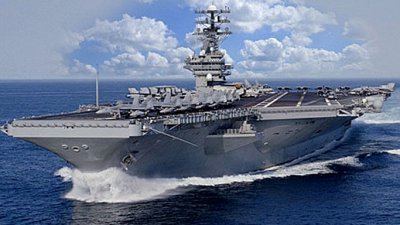
Carrier Air Wing Eleven, normally assigned to USS Nimitz, embarked only 25 percent of its total strength for the transit. The squadrons making the transit were VFA-14 and VFA-41 flying the F/A-18E/F Super Hornet, VAW-117 flying the E-2C Hawkeye 2000, HS-6 flying the SH-60F Seahawk and VRC-30 flying the C-2A Greyhound. The ship visited Rio de Janeiro, Brazil on 5 June 2004 and during the first evening after arrival the ship's namesake Ronald Reagan died. A ceremony in his honor was held onboard later that evening, soon after the US national anthem was publicly played. After leaving Rio, Reagan transited the Strait of Magellan on 20–21 June and subsequently made port visits to Valparaíso, Chile, and Callao, Peru before arriving in San Diego on 23 July 2004. From 1 October 2004, Reagan was assigned to Carrier Strike Group Fifteen.
2006 maiden deployment
USS Ronald Reagan departed San Diego on 4 January 2006, on her maiden deployment to conduct naval operations in support of Operation Iraqi Freedom and Operation Enduring Freedom, as well as to conduct maritime security operations (MSO) in the Persian Gulf. On 28 January 2006, an F/A-18 Hornet strike fighter attempting a night landing aboard Reagan crashed into the ship's flight deck about 200 kilometres (120 mi) southeast of Brisbane, Queensland. The aircraft struck the ramp at a low angle, caught fire and skidded overboard. The pilot ejected safely, but the aircraft was lost. The ship entered the Persian Gulf on 22 February 2006, and returned from deployment on 6 July 2006.
2007 surge deployment
USS Ronald Reagan and the Reagan Carrier Strike Group (CSG) departed North Island, Coronado in San Diego on 27 January 2007 on an unscheduled surge deployment to the Western Pacific, fulfilling the role of the forward deployed carrier Kitty Hawk while it underwent maintenance in Japan. On 20 April 2007, Ronald Reagan and her CSG returned to Coronado. The "surge deployment" was part of the Navy's Fleet Response Plan (FRP), which provides the U.S. with the ability to respond to any global commitment with flexible and sustainable forces and the ability to rapidly respond to a range of situations on short notice.
In January 2007, it was announced that Ronald Reagan had earned the 2006 Commander, Naval Air Forces Pacific Carrier Battle Efficiency "E" award for the West Coast, the first Battle "E" ever for the carrier.
Reagan returned to Naval Air Station North Island on 20 April 2007, following the three-month deployment in support of operations in the Western Pacific.
On 15 December 2007, the carrier answered a distress call from a cruise ship off the coast of Baja California. An Illinois teenager whose appendix had ruptured while on a Mexican cruise was airlifted by an SH-60 helicopter to Ronald Reagan, where an emergency appendectomy was performed by the ship's surgeon.
2008 deployment
USS Ronald Reagan, with CVW-14 embarked, departed San Diego on 19 May 2008, for a scheduled 7th Fleet and 5th Fleet deployment.
The Reagan Carrier Strike Group performed humanitarian assistance and disaster relief operations in the Philippines on 24 June 2008 after that country was devastated by Typhoon Fengshen, killing hundreds from the central island regions and the main island of Luzon. The typhoon also capsized the passenger ferry MV Princess of the Stars. Working in support of the Armed Forces of the Philippines, Reagan and her escorts of Carrier Strike Group 7 focused their efforts on the island of Panay in the Central Visayas. For eight days, SH-60 Seahawk helicopters and C-2A Greyhound aircraft of the Ronald Reagan Strike Group helped deliver more than 519,000 lb (235,000 kg) of rice, fresh water and other supplies to areas of Panay, which were not reachable via truck due to flooded roads. The mission in Panay would earn the entire strike group the Navy's Humanitarian Service Medal.
The Strike Group arrived in the U.S. Fifth Fleet area on 28 August 2008, where she launched more than 1,150 sorties into Afghanistan in support of Operation Enduring Freedom. Reagan returned to San Diego on 25 November 2008.
USS Ronald Reagan received word in February 2009 that the ship had won its second Battle Effectiveness Award.
2009 deployment
On 28 May 2009, Reagan deployed with Carrier Air Wing 14 to the 7th and 5th Fleet Areas of Responsibility. Reagan relieved the Eisenhower CSG and launched its first sorties in support of OEF on 6 July. Reagan returned to homeport on 21 October after a five-month deployment.
2010
In early 2010, Reagan was awarded the 2009 Chief of Naval Operations Afloat Safety "S" Award, and the 2009 Pacific Fleet Battle "E" for combat efficiency. The Battle "E" award was Reagan's second consecutive and third in four years.
On 19 May 2010, Norfolk Naval Shipyard (NNSY) completed the six-month Planned Incremental Availability (PIA) maintenance cycle on Reagan. This PIA project came in under budget, and it marked both Norfolk Naval Shipyard's largest off-site availability as well as the largest public sector work package ever performed on an aircraft carrier berthed at Naval Air Station North Island (NASNI) located near Coronado, California (pictured). During the maintenance period, Ronald Reagan received technological upgrades that prepared it for its next deployment and subsequent operations. Refurbishments included hi-tech combat systems and firefighting equipment to improved ship's laundry services and living spaces. This PIA maintenance project was an example of the 'One Shipyard' concept wherein the U.S. Navy mobilizes its work force across its various shipyards to better meet fleet readiness requirements as well as to stabilize a vital workforce base for the U.S. defense industry. While Norfolk Naval Shipyard was the project lead, significant work was done by its partners: Puget Sound Naval Shipyard & Intermediate Maintenance Facility (PSNS & IMF), Southwest Regional Maintenance Center (SWRMC), Northrop Grumman Shipbuilding (NGSB).
During peak manning, approximately 1,400 worked the project on a daily basis. This included approximately 625 NNSY personnel, 165 PSNS & IMF employees, and 600 from SWRMC/NGSB.
On 18 May 2010, Reagan departed Naval Air Station North Island for sea trials. The sea trial was the final phase of the PIA, and it was conducted to assess the carrier's material readiness to return to the operational fleet. Reagan pulled into Naval Air Station North Island on 19 May 2010 after completing its two-day sea trial, marking the official end to its six-month planned incremental availability (PIA) maintenance period.
On 2 June 2010, Ronald Reagan, with Carrier Air Wing Fourteen (CVW-14) embarked, departed Naval Air Station North Island to conduct flight deck certifications. The first CVW-14 aircraft to land on aircraft carrier's flight deck was from Helicopter Anti-Submarine Squadron 4 (HS-4). Other embarked squadrons included: Marine Fighter Attack Squadron 323 (VMFA-323), Strike Fighter Squadron 154 (VFA-154), Strike Fighter Squadron 147 (VFA-147)* Strike Fighter Squadron 146 (VFA-146), Airborne Early Warning Squadron 113 (VAW-113), Fleet Logistics Squadron 30 (VRC-30) The certification included a full evaluation of the arresting gear, steam catapults, and flight deck personnel. Reagan's air department was assessed on its ability to maintain a fully operational flight deck and respond to simulated mishaps.
During the summer of 2010 Ronald Reagan participated in Exercise RIMPAC, departed from Naval Air Station North Island, California, for a Board of Inspection and Survey (INSURV) assessment on 25 August 2010, and departed her homeport to conduct routine operations off the coast of southern California in preparation for its 2011 Western Pacific (WESTPAC) deployment. In November 2010, the ship provided emergency supplies and assistance to passengers stranded in the Pacific Ocean aboard the Carnival Splendor, which had lost power by an engine fire.
2011
The ship departed for an Asian deployment on 2 February 2011. On 11 March 2011, Reagan was in the Korean peninsula region for a long-planned exercise off Korea, but was redirected towards Japan to provide support after the massive 2011 Tōhoku earthquake and tsunami. The ship, stationed off Sendai, served as a refueling station for Japanese coast guard and military helicopters on relief missions in the area. US Navy helicopters also flew relief missions from the carrier. On 13 March 2011, the ship measured 0.6 mR/hr direct gamma shine from clouds 130 miles (≈210 km) from the Fukushima Daiichi Nuclear Power Plant. Members of the crew blamed their cancers on the event. On 14 March 2011, the ship was forced to relocate to avoid a radioactive plume from the Fukushima I nuclear accidents which had contaminated 17 crew members of three helicopter crews. On 23 March, Reagan's crew performed radiation decontamination by scrubbing down any surface that could have been contaminated, including the island superstructure and flight deck, to remove any potential radiation hazards. On 4 April 2011, Japan's minister of defense, Toshimi Kitazawa, accompanied by US ambassador to Japan John Roos, visited the ship to thank its crew for its assistance as part of Operation Tomodachi. Said Kitazawa, "I have never been more encouraged by and proud of the fact that the United States is our ally." The ship returned to San Diego on 8 September 2011. In January 2011, the Navy announced that the aircraft carrier would be transferred to the Puget Sound Naval Ship Yard in Bremerton, Washington for scheduled repair and maintenance beginning January 2012.
2012 and 2013
On 10 January 2012 Reagan's official home port was changed to Bremerton, Washington, where she stayed for a little over a year until returning to her home port of San Diego on 21 March 2013. For the sailors being relocated, the Navy had many of their vehicles transported on the deck of the ship as a cost-saving measure.
2014
On 14 January 2014, the Navy announced that Ronald Reagan would replace her sister ship George Washington as the Seventh Fleet forward deployed carrier at Yokosuka, Japan in 2015.
2015
On 1 October 2015, Ronald Reagan arrived in its newest home port, Yokosuka Kanagawa Prefecture, Japan replacing USS George Washington and taking its new place as the flagship of Carrier Strike Group Five and Carrier Air Wing Five (CVW-5). It was open for the public to tour on October 12.
2016
On 4 June 2016, Ronald Reagan left its base in Yokosuka. It was deployed with "Carrier Strike Group 5" to the South China Sea before an international tribunal released its decision regarding a China and Philippines conflict. It returned after a 53-day cruise for a mid-cruise break and conducted Board of Inspection and Survey (INSURV) inspections designed to ensure the ship lasts for its full 50-year lifespan. It temporarily left port due to Typhoon Lionrock. After completing INSERV it returned to sea on September 3. It then participated in Exercise Valiant Shield 2016 before making a port call at Guam, and participating in "Invincible Spirit", a joint exercise with South Korean forces in the Sea of Japan and the Yellow Sea.
2017
From January 10 the ship began a period of Selected Restricted Availability with a focus on part of the ship including the flight deck, its hangar bays and also general living spaces.
Commanding officers
Gallery
Click on the thumbnail to enlarge.
